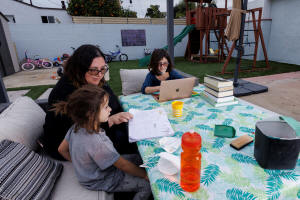Exhausted parents navigate a patchwork of U.S. school COVID-19 policies
 Send a link to a friend
Send a link to a friend
 [January 14, 2022]
By Sharon Bernstein and Joseph Ax [January 14, 2022]
By Sharon Bernstein and Joseph Ax
SACRAMENTO, Calif. (Reuters) - Jennifer
Pierre speaks for millions of American parents when she sums up how it
feels to navigate a patchwork of school COVID-19 policies as the
pandemic enters a third year.
"It's so exhausting," the Sacramento, California, mother said this week.
She is happy to see her 13-year-old daughter and 10-year-old son back in
their classrooms after the long months of remote learning that hindered
their social development. But even with her school district's strict
safety protocols, she worries about whether the surging Omicron variant
https://tmsnrt.rs/2WTOZDR will lead to further closures and on what
grounds those will be decided.
"Instead of 2020, where it was stay home, wash your hands, don't touch
anybody, now it's more complicated," said Pierre, 40. "The rules aren't
clear."
Across the United States, schools are following protocols that vary from
state to state and even city to city. Some districts require masks and
regular testing, but others do not. Many are staying open for in-person
learning, while some are shutting down, at times with little notice.
Some allow students exposed to COVID to stay in school, while others
send them home for anywhere from five to 14 days.
There were almost 5,000 schools nationwide that were closed or remote
one or more days this week due to COVID-19, according to Burbio, a
website that tracks school disruptions.

The confusing situation has left many parents frustrated and angry - and
sometimes feeling like they have been left on their own to decide
whether it is safe to send their kids to school.
In New Jersey, Kristen Verrier, 46, is managing two children whose
school abruptly switched to remote learning for two weeks, another who
is attending class in person and a college-age daughter who decided to
take a year off as the pandemic wreaks havoc on yet another term.
As president of the parent-teacher organization for the River Dell
Regional school district, Verrier said she also is fielding questions
from other parents facing the myriad daily judgment calls that have
become part of pandemic life.
“What should we be doing?” she said they ask, as they grapple with
things like whether to send a student to attend a sports practice even
if school is shut down.
'CHICKEN POX PARTY'
Yelena Wheeler has yet to send her kids ages 5 and 8 to class in
Burbank, California, two weeks after their winter break ended.
The ever-changing safety rules and lack of strict testing protocols in
their district convinced the hospital dietician and her husband, an
emergency room nurse, that it would be wiser to try to teach their
children at home.
"The virus is rampant, and I just would not want to participate in this
chicken pox party," she said.

[to top of second column]
|

Yelena Wheeler homeschools her two daughters Cambria, 8, and C.J.,
5, from their backyard during the outbreak of the coronavirus
disease (COVID-19), in Burbank, California, U.S., January 13, 2022.
REUTERS/Mike Blake
 Taylor Calderone was all set to send
her 8-year-old daughter and 6-year-old son back to school in River
Edge, New Jersey, after the holiday break for the first time since
the pandemic started. But on the evening of Jan. 2, just hours
before they were planning to wake up and head to class, she changed
her mind.
The unknowns of the Omicron variant and her fears
about "long COVID," a constellation of symptoms that some patients
have reported experiencing for weeks or months after recovering from
the primary infection, prompted the change of heart. After nearly
two years of home schooling, she also knew her family could handle
it, even if it isn't ideal.
“What we all want for our kids right now is their childhood back,”
said Calderone, 37, a stay-at-home mom. “It’s so hard to provide
them with a sense of security and comfort – and then when we make
these predictions and they turn out not to be true. Navigating that
space has been really difficult.”
Other parents have been forced to scramble as worries about
Omicron's spread led a number of districts to abruptly announce days
off and teachers in Chicago, Oakland and Louisiana to stage walkouts
to protest what they say are unsafe conditions.
The Biden administration this week announced a new set of measures
aimed at keeping classrooms open, including doubling COVID-19
testing capacity in schools with 10 million more tests.
School officials say they have implemented outreach efforts to keep
parents informed of changes in public health rules.
When the Los Angeles school board voted just days before the start
of school to require a baseline COVID-19 test for everyone, a
massive communications effort was launched to make sure parents knew
about it, including social media posts, local news appearances and
emails to parents, said Frances Baez, an area superintendent.
But even with the nation's second-largest school district having
some of the country's strongest protections for teachers and
students, more disruptions are to be expected as the pandemic drags
on, said Cecily Myart-Cruz, president of United Teachers Los
Angeles.

"No one has a playbook for this moment," she said.
Los Angeles parent Eve Tronson is sending her kids to their
kindergarten and middle school classes but trying to reduce risk in
other areas of their lives. They upgraded their masks, avoid indoor
dining in restaurants and limit play dates.
"They need social interaction and some continuity," said Tronson. "I
pray that we get through it."
(Reporting by Sharon Bernstein in Sacramento, California, and Joseph
Ax in Princeton, New Jersey; Editing by Colleen Jenkins and Lisa
Shumaker)
[© 2022 Thomson Reuters. All rights
reserved.] This material may not be published,
broadcast, rewritten or redistributed.
Thompson Reuters is solely responsible for this content. |